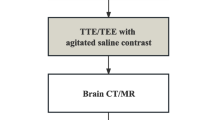Abstract
The aim of this preliminary case-control study was to compare, in patients with migraine and PFO, transcatheter closure of PFO vs. medical treatments. Twelve patients were treated with antimigraine drugs and twelve underwent percutaneous transcatheter closure. All patients were followed-up for 12 months. Our preliminary results seem to confirm that, compared to medical treatment, PFO closure is by far more effective in reducing both frequency, duration and intensity of migraine attacks. Furthermore, the occurrence of prodromal aura is almost abolished.
Similar content being viewed by others
References
Rasmussen BK, Jensen R, Schroll M, Olsen J. Epidemiology of headache in a general population-a prevalence study. J Clin Epidemiol. 1991;44:1147–1157
Pryse-Phillis W, Findlay H, Tugwell P, Edmeads J, Murray TJ, Nelson RF. A Canadian population survey on the clinical, epidemiologic and societal impact of migraine and tension-type headache. Can J Neurol Sci. 1992;19:333–339
Stewart WF, Lipton RB, Celentano DD, Reed ML. Prevalence of migraine in the United States. JAMA 1992;267:64–9
Lipton RB, Silberstain SD, Steward WF. An update on migraine epidemiology. Headache 1994;34:319–28
Headache Classification Committee of the International Headache Society. Classification and diagnostic criteria for headache disorders, cranial neuralgias and facial pain. Cephalalgia 1998; 8 (suppl 7):1–96
Anzola GP, Magoni M, Guindani M, Rozzini L, Dalla Volta G. Potential source of cerebral embolism in migraine with aura: a transcranial Doppler Study. Neurology 1999;52:1622–1625
Del Sette M, Angeli S, Leandri M et al. Migraine with aura and right-to-left shunt on transcranial Doppler: a case-control study. Cerebrovasc Dis 1998;8:327–330
Silberstein SD, Lipton RB, Goadsby PJ. Headache in Clinical Practice. Isis Medical Media, Silberstein SD, Lipton RB, Goadsby PJ (eds), Oxford, 1998
Morandi E, Anzola GP, Casilli F, Onorato E. Transcatheter closure of patent Foramen Ovale: a New Migraine Treatment? J Intervent Cardiol 2003; 16:39–42
Jauss M, Zanette E. Detection of right-to-left shunt with ultrasound contrast agent and transcranial Doppler sonography. Cerebrovasc Dis 2000;10:490–496
Wilmshurst P T, Nightingale S, Walsh K P, Morrison W L. Effect on migraine of closure of cardiac right-to-left shunts to prevent recurrence of decompression illness or stroke or for haemodynamic reasons. Lancet 2000;356:1648–51
Schwerzmann M, Wiher S, Nedeltchev K, Mattle HP, Wahl A, Seile C, Meier B, Windecker S. Percutaneous closure of patent foramen ovale reduces the frequency of migraine attacks. Neurology 2004;62:1399–401
Post MC, Thijs V, Herroelen L, Budts WI. Closure of a patent foramen ovale is associated with a decrease in prevalence of migraine. Neurology 2004;62:1439–40
Ende DJ, Chopra PS, Rao PS. Transcatheter closure of atrial septal defect of patent foramen ovale with the buttoned device for prevention of recurrence of paradoxic embolism. Am J Cardiol 1996;78:233–6
Martin F, Sanchez PL, Doherty E, Colon-Hernandez PJ, delgado G, Inglessis I, Scott H, Hung J, King ME, Buonanno F, Demirjian Z, de Moor M, Palacios IF. Percutaneous transcatheter closure of patent foramen ovale in patients with paradoxical embolism. Circulation 2002;106:1121–6
Sievert H, Babic UV, Hausdorf G, Schneider M, Hopp HW, Pfeiffer D, Pfisterer M, Friedli B, Urbason P. Transcatheter closure of atrial septal defct and patent foramen ovale with ASDOS ( a multi-institutional European trial). Am J Cardiol 1998;82:1405–13
Anzola GP, Morandi E, Casilli F, Onorato E. Does transcatheter closure really “shut the door”?: a prospective study with transcranial doppler. Stroke 2004 (article in press)
Ferrari J, Baumgartner H, Tentschert S, Dorda V, Lang W, Willfort P, Ehringer A, Probst P, Lalouscek W. Cerebral microembolism during transcatheter closure of patent foramen ovale. J Neurol 2004;251:825–9
Kruit MC, van Buchem MA, Hofman PAM, Bakkers JTN, Terwindt GM, Ferrari MD, Launer LJ Migraine as a Risk Factor for Subclinical Brain Lesions JAMA. 2004;291:427–434
Sandler M. Migraine a pulmonary disease? Lancet 1972;1:618–619
Author information
Authors and Affiliations
Corresponding author
Rights and permissions
About this article
Cite this article
Morandi, E., Anzola, G., Casilli, F. et al. Migraine: Traditional or “Innovative” Treatment? A Preliminary Case-Control Study. Pediatr Cardiol 26, 231–233 (2005). https://doi.org/10.1007/s00246-005-1006-4
Published:
Issue Date:
DOI: https://doi.org/10.1007/s00246-005-1006-4




